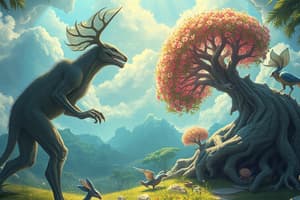Podcast
Questions and Answers
Which type of natural selection favors individuals with extreme traits compared to those with intermediate traits?
Which type of natural selection favors individuals with extreme traits compared to those with intermediate traits?
- Stabilizing Selection
- Directional Selection
- Artificial Selection
- Disruptive Selection (correct)
What is the correct order of taxonomic ranks from broadest to most specific?
What is the correct order of taxonomic ranks from broadest to most specific?
- Domain, Kingdom, Phylum, Class, Order, Family, Genus, Species (correct)
- Species, Genus, Family, Order, Class, Phylum, Kingdom, Domain
- Kingdom, Domain, Phylum, Class, Order, Family, Genus, Species
- Phylum, Domain, Kingdom, Class, Order, Family, Genus, Species
How do bacteria reproduce asexually?
How do bacteria reproduce asexually?
- Binary Fission (correct)
- Mitosis
- Budding
- Meiosis
Which of the following is NOT a mechanism that contributes to genetic diversity during meiosis?
Which of the following is NOT a mechanism that contributes to genetic diversity during meiosis?
Which of the following is considered the pacemaker of the heart?
Which of the following is considered the pacemaker of the heart?
Which blood vessel carries deoxygenated blood back to the heart?
Which blood vessel carries deoxygenated blood back to the heart?
Which type of plant tissue is responsible for primary growth, increasing the length of the plant?
Which type of plant tissue is responsible for primary growth, increasing the length of the plant?
What is the primary factor affecting breathing rate?
What is the primary factor affecting breathing rate?
What is the function of the small intestine in the digestive system?
What is the function of the small intestine in the digestive system?
Which of the following events does NOT occur during the process of alternation of generations in plants?
Which of the following events does NOT occur during the process of alternation of generations in plants?
What is the difference between vital capacity and tidal volume?
What is the difference between vital capacity and tidal volume?
Which of the following is NOT a valve found in the heart?
Which of the following is NOT a valve found in the heart?
Which of the following describes a type of evolution where two species evolve in response to each other?
Which of the following describes a type of evolution where two species evolve in response to each other?
What is the primary purpose of meiosis in an organism?
What is the primary purpose of meiosis in an organism?
How do incomplete dominance and complete dominance differ?
How do incomplete dominance and complete dominance differ?
Which of the following accurately represents the process of spermatogenesis?
Which of the following accurately represents the process of spermatogenesis?
What genetic disorder is characterized by an extra chromosome 21?
What genetic disorder is characterized by an extra chromosome 21?
Which mechanism represents a pre-zygotic isolation mechanism?
Which mechanism represents a pre-zygotic isolation mechanism?
Flashcards
Trisomy
Trisomy
A condition where a cell has one extra chromosome (ex: Down Syndrome, Trisomy-21).
Monosomy
Monosomy
A condition where a cell is missing a chromosome (ex: Turner syndrome, Monosomy-X).
Lamarckism
Lamarckism
A type of evolution where organisms change through the inheritance of acquired traits (e.g., the giraffe's long neck).
Meiosis
Meiosis
Signup and view all the flashcards
Mitosis
Mitosis
Signup and view all the flashcards
Allopatric Speciation
Allopatric Speciation
Signup and view all the flashcards
Sympatric Speciation
Sympatric Speciation
Signup and view all the flashcards
Disruptive Selection
Disruptive Selection
Signup and view all the flashcards
Directional Selection
Directional Selection
Signup and view all the flashcards
Stabilizing Selection
Stabilizing Selection
Signup and view all the flashcards
Co-evolution
Co-evolution
Signup and view all the flashcards
Convergent Evolution
Convergent Evolution
Signup and view all the flashcards
Adaptive Radiation
Adaptive Radiation
Signup and view all the flashcards
What are the two events that occur during meiosis that lead to genetic diversity?
What are the two events that occur during meiosis that lead to genetic diversity?
Signup and view all the flashcards
Define peristalsis
Define peristalsis
Signup and view all the flashcards
Know the meaning of the alternation of generations
Know the meaning of the alternation of generations
Signup and view all the flashcards
The function of the small intestine
The function of the small intestine
Signup and view all the flashcards
How are annual rings in a tree formed?
How are annual rings in a tree formed?
Signup and view all the flashcards




